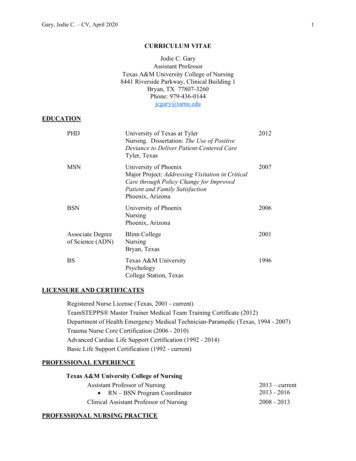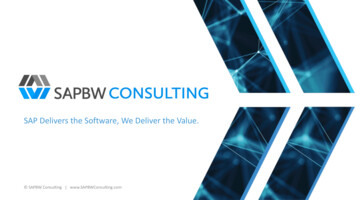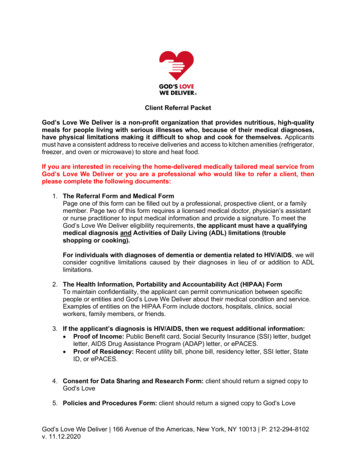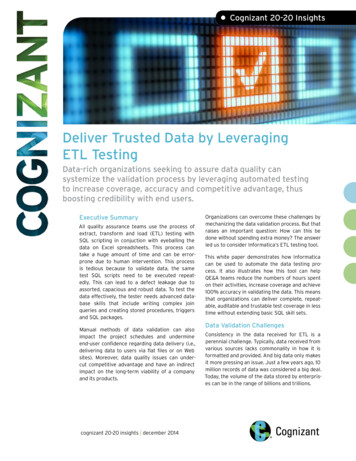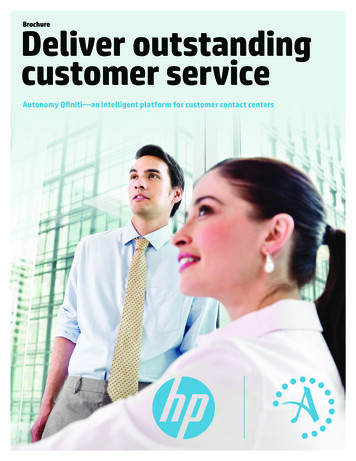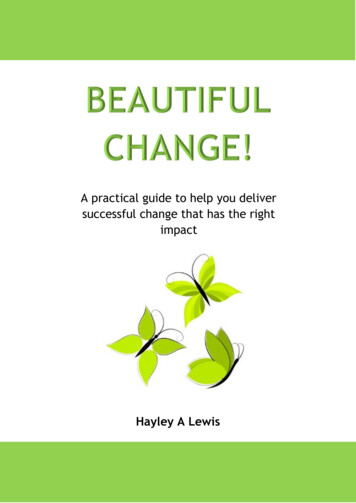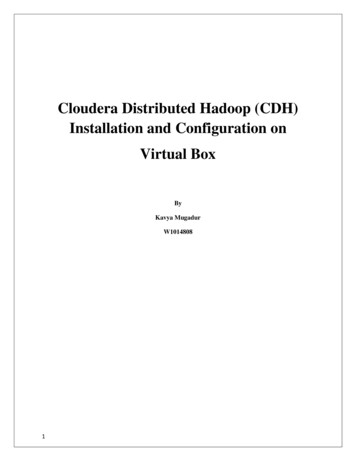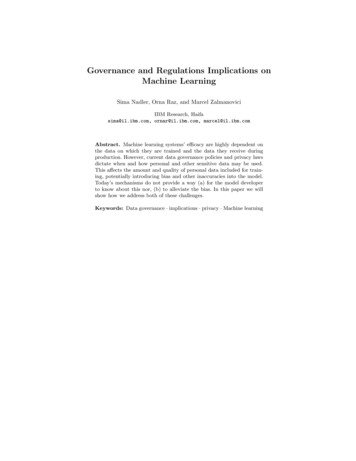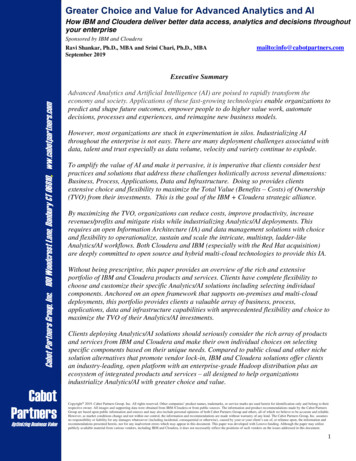
Transcription
Greater Choice and Value for Advanced Analytics and AIHow IBM and Cloudera deliver better data access, analytics and decisions throughoutyour enterpriseSponsored by IBM and ClouderaRavi Shankar, Ph.D., MBA and Srini Chari, Ph.D., MBASeptember 2019mailto:info@cabotpartners.comCabot Partners Group, Inc. 100 Woodcrest Lane, Danbury CT 06810, ww.cabotpartners.comExecutive SummaryCabotPartnersOptimizing Business ValueAdvanced Analytics and Artificial Intelligence (AI) are poised to rapidly transform theeconomy and society. Applications of these fast-growing technologies enable organizations topredict and shape future outcomes, empower people to do higher value work, automatedecisions, processes and experiences, and reimagine new business models.However, most organizations are stuck in experimentation in silos. Industrializing AIthroughout the enterprise is not easy. There are many deployment challenges associated withdata, talent and trust especially as data volume, velocity and variety continue to explode.To amplify the value of AI and make it pervasive, it is imperative that clients consider bestpractices and solutions that address these challenges holistically across several dimensions:Business, Process, Applications, Data and Infrastructure. Doing so provides clientsextensive choice and flexibility to maximize the Total Value (Benefits – Costs) of Ownership(TVO) from their investments. This is the goal of the IBM Cloudera strategic alliance.By maximizing the TVO, organizations can reduce costs, improve productivity, increaserevenues/profits and mitigate risks while industrializing Analytics/AI deployments. Thisrequires an open Information Architecture (IA) and data management solutions with choiceand flexibility to operationalize, sustain and scale the intricate, multistep, ladder-likeAnalytics/AI workflows. Both Cloudera and IBM (especially with the Red Hat acquisition)are deeply committed to open source and hybrid multi-cloud technologies to provide this IA.Without being prescriptive, this paper provides an overview of the rich and extensiveportfolio of IBM and Cloudera products and services. Clients have complete flexibility tochoose and customize their specific Analytics/AI solutions including selecting individualcomponents. Anchored on an open framework that supports on-premises and multi-clouddeployments, this portfolio provides clients a valuable array of business, process,applications, data and infrastructure capabilities with unprecedented flexibility and choice tomaximize the TVO of their Analytics/AI investments.Clients deploying Analytics/AI solutions should seriously consider the rich array of productsand services from IBM and Cloudera and make their own individual choices on selectingspecific components based on their unique needs. Compared to public cloud and other nichesolution alternatives that promote vendor lock-in, IBM and Cloudera solutions offer clientsan industry-leading, open platform with an enterprise-grade Hadoop distribution plus anecosystem of integrated products and services – all designed to help organizationsindustrialize Analytics/AI with greater choice and value.Copyright 2019. Cabot Partners Group. Inc. All rights reserved. Other companies’ product names, trademarks, or service marks are used herein for identification only and belong to theirrespective owner. All images and supporting data were obtained from IBM /Cloudera or from public sources. The information and product recommendations made by the Cabot PartnersGroup are based upon public information and sources and may also include personal opinions of both Cabot Partners Group and others, all of which we believe to be accurate and reliable.However, as market conditions change and not within our control, the information and recommendations are made without warranty of any kind. The Cabot Partners Group, Inc. assumesno responsibility or liability for any damages whatsoever (including incidental, consequential or otherwise), caused by your or your client’s use of, or reliance upon, the information andrecommendations presented herein, nor for any inadvertent errors which may appear in this document. This paper was developed with Lenovo funding. Although the paper may utilizepublicly available material from various vendors, including IBM and Cloudera, it does not necessarily reflect the positions of such vendors on the issues addressed in this document.1
Huge Value of Analytics, AI and Machine Learning (ML)Analytics, Artificial Intelligence (AI) and Machine Learning (ML) are profoundlytransforming how businesses and governments engage with consumers and citizens. Acrossmany industries, high value transformative use cases in personalized medicine, predictivemaintenance, fraud detection, cybersecurity and more (Figure 1) are rapidly emerging. Infact, AI/ML adoption alone has grown an astounding 270% in the last four years and 40% oforganizations expect it to be a game changer.1 The economic impact of AI/ML is immense.AI adoptiongrown 270%and 40% oforganizationsthink it is gamechangingHigh value AIuse cases inmanyindustriesFigure 1: High Value Use Cases of Analytics and AIAnother recent survey2 indicates that over the next five years AI is expected to have apositive impact on growth (90%), productivity (86%), innovation (84%) and job creation(69%). 77% of respondents expect AI to improve the sustainability of economic growth.But many AIdeploymentchallengeslimitwidespread useHowever, for Analytics, AI and ML to become a crucial integral part of an organization,numerous challenges must be overcome. In fact, 77% of respondents in another recentsurvey3 say that “business adoption” of big data and AI initiatives continues to be achallenge and only 31% have a data-driven organization, fewer (28%) have a data culture.To amplify the value of AI and make it pervasive, it is imperative that clients consider bestpractices and solutions that address these challenges holistically across several dimensions:Business, Process, Applications, Data and Infrastructure. Doing so will enable clients tomaximize their Total Value of Ownership (TVO) from their investments. This is the goal ofthe IBM Cloudera strategic alliance.Need ns,Data andInfrastructuredimensionsBest Practices to Maximize TVO of Analytics and AI InvestmentsAI is rapidly shaping the future of work by enabling organizations to predict and shapefuture outcomes, empower people to do higher value work, automate decisions, pectives.economist.com/sites/default/files/EIU Microsoft%20%20Intelligent%20Economies society.pdf3New Vantage Partners, “Big Data and AI Executive Survey 2019 Executive Summary of Findings”, 2019.22
72 % of AIpioneers seevalue withhigherrevenues, 28%see costsavingsand experiences, and reimagine new business models. In fact, AI pioneers see more value inthe form of higher revenues (72%) and then secondarily in cost savings (28%).4 Which iswhy organizations must carefully assess the total value of their AI /Analytics investments.The TVO framework (Figure 2) goes beyond just the Total Cost of Ownership (TCO). Itcategorizes interrelated cost/value drivers (circles) for Analytics and AI by each quadrant:Costs, Productivity, Revenue/Profits and Risks. Along the horizontal axis, the drivers arearranged based on whether they are primarily Technical or Business drivers. Along thevertical axis, drivers are arranged based on ease of measurability: Direct or Derived.Total Value /derivedcost and valuedrivers forAnalytics/AI.MaximizingTVO impliesLower Costs,EnhancedProductivity,HigherRevenues/Profits andMitigated Risks51% oforganizationstuck in AIexperimentationand over 60%face Data,Talent and TrustissuesFigure 2: TVO Framework with Cost and Value Drivers for Analytics and AIThe cost/value drivers for Analytics/AI are depicted as circles whose size is proportional tothe potential impact on a client’s Total Value (Benefits – Cost) of Ownership as follows:1. TCO: Costs for infrastructure, software, deployment, maintenance, operations, etc.2. Enhanced Productivity: Productivity gains of data scientists, data engineers, developers,analysts and the organization because of automation and shift to higher value work.3. Higher Revenue/Profits: Better able to predict and shape future outcomes and reimaginenew business models to spur growth, revenues and improve profits.4. Risk Mitigation: Lower risk of project failure (even well-planned Analytics projects haveup to 60% failure rate5) with better governance, security, privacy and compliance.To maximize the TVO, organizations must operationalize, sustain and scale Analytics/AI.However, today, about 51% of organizations are stuck in experimentation because over 60%of organizations face challenges associated with Data, Talent and Trust.6 To quickly identifyand implement high value Analytics and AI use-cases, organizations need to overcome theseSam Ransbotham, David Kiron, Philipp Gerbert, and Martin Reeves, “Reshaping Business with Artificial Intelligence”, MIT SloanManagement Review, 2017.5Why big data projects fail and how to make 2017 different, Expansion of Gartner’s prediction that 60% of big data projects fail; By SameetAgarwal, Network World Feb 16, 2017.6Forrester, “Challenges that hold firms back from achieving AI aspirations”, 2019.43
challenges and leverage corresponding emerging best practices7 8 9 (Figure 3) in a consistentand repeatable manner at scale, across the business to maximize Analytics/AI value.Need holisticapproach toaddress AIchallenges withcorrespondingbest practicesMust ionandInfrastructuretogetherIndustrializingAI needs anintricate,ladder-likeworkflow togather,arrange andanalyze dataFigure 3: Challenges and Corresponding Best Practices for Analytics and AIBy implementing these best practices, customers can collaborate to gather data and make itsimple and accessible, arrange to create a business-ready analytics foundation such as a datawarehouse for Business Intelligence (BI), analyze to build Analytics and AI with trust andtransparency and to operationalize and industrialize AI across the business.NeedsInformationArchitecture(IA)“There is no AIwithout anopen androbust IA”This intricate, multistep, ladder-like journey and workflow is crucial to industrialize AI.However, this requires an open Information Architecture (IA) and data managementsolutions with choice and flexibility. “There is no AI without a robust and open IA”. IBMand Cloudera deliver this open IA to clients on their journey to operationalize Analytics/AI.7https://www.mckinsey.com/ ions4
The Analytics and AI Workflow Requires an Open PlatformManaging dataacross the AIworkflow isvexing80% ofcompany datais fragmentedin silosCompared to the much-hyped focus on the compute-intensive training and inference tasks,there is little appreciation of the complexities and importance of data management. One ofthe most vexing challenges in deploying AI is how to manage all the data used throughoutthe workflow (Figure 4). The AI/Analytics workflow has more green data managementblocks and fewer blue and red compute-intensive applications boxes.AI algorithms become more accurate and efficient the more they get trained on largevolumes of data from many sources, including valuable enterprise data. However,company-specific data is often fragmented – 80% of this data is locked in siloes and noteasily accessible. So, it is important to have robust processes to regularly gather andarrange this diverse data from numerous sources and integrate it into the manyconstantly improving training models to deliver better insights and business value.AI Workflow:Data toFoundation toModels toInsights toBusiness ValueFigure 4: A Typical Intricate Iterative Analytics/AI WorkflowThe various phases of a typical, intricate and iterative Analytics/AI workflow (Data toFoundation to Models to Insights to Business Value) are shown in Figure 4.Gather data tomake it simpleand accessible1. Gather: The first step in any Analytics/AI workflow is to acquire the data which can bestructured or unstructured. It is important to accurately track data provenance, i.e., whereeach piece of data comes from and whether it is still up to date, since data often needs tobe re-acquired in the future to run updated experiments.With data streaming in from hundreds of sensors, a single source (vehicle, plantequipment, building, gene sequencing machine, etc.) can produce terabytes of data eachday. However, Data Scientists typically do not look at just one source. They may have tolook at numerous sources and as time goes on, might have multiple Analytics/AI models,with multiple versions and hundreds of different data subsets. So, the data/storagemanagement challenges compound exponentially.5
Dealing with raw data is also not very convenient since it was generated and formattedwithout considering analysis requirements. Raw data often contains semantic errors,missing entries, or inconsistent formatting, so it needs to be "cleaned" prior to analysis.xxxxxxxData scientistsspend 80% oftheir timefinding,cleansing andarranging dataThis is a big challenge as data collection and preparation are very time-consumingactivities – Data Scientists spend about 80 percent10 of their time simply finding,cleansing and arranging data. So, solutions that
16.02.2017 · publicly available material from various vendors, including IBM and Cloudera, it does not necessarily reflect the positions of such vendors on the issues addressed in this document. Greater Choice and Value for Advanced Analytics and AI How IBM and Cloudera deliver better data access, analytics and decisions throughout your enterprise Sponsored by IBM and Cloudera Ravi Shankar,




